This Whole Wheat Artisan Sourdough Bread recipe is one of my favourite ways to bake with fresh milled flour. It’s simple to put together, with a rich, wholesome flavour and a pleasantly hearty texture. Best of all, using freshly milled flour makes it as nourishing as it is delicious.
This post may contain affiliate links – as an Amazon Associate, I earn from qualifying purchases, at no extra cost to you. Thank you for your support!
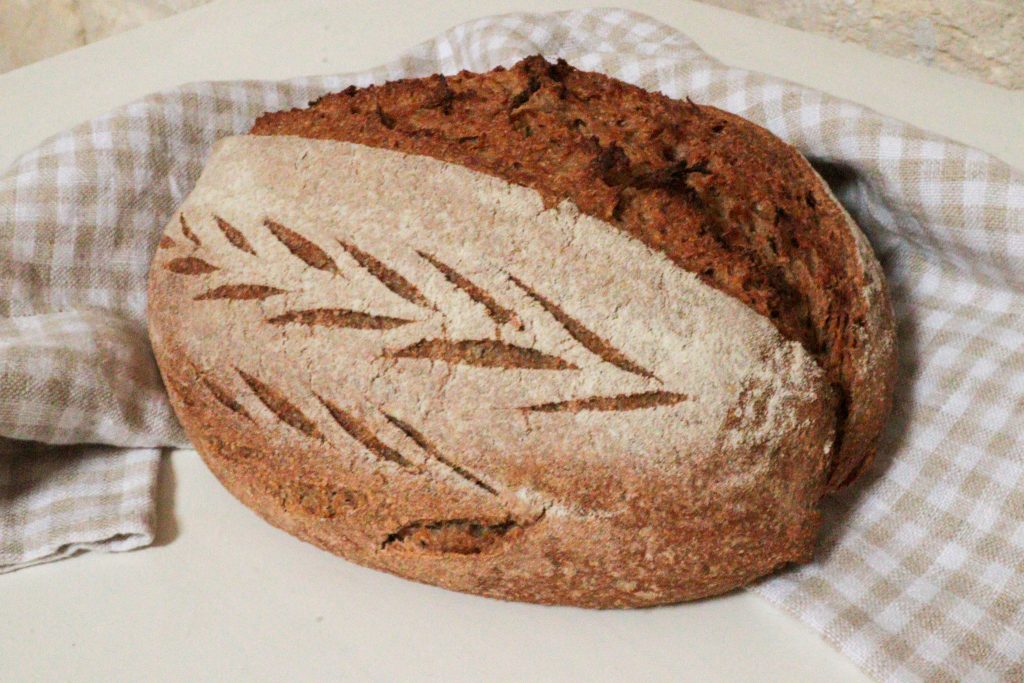
Why You Will Love This Recipe
If you’re looking for a whole wheat artisan sourdough bread recipe that still tastes delicious and is not too dense, this one ticks all the boxes.
When I started baking with fresh milled flour, I made plenty of mistakes, and plenty of dense bread! After trial and error, I settled on this recipe that works every time.
Many say the only way to enjoy fresh milled flour bread is as enriched sandwich loaves with egg and oil. While those are soft and delicious, I disagree. In our family, we don’t really enjoy loaves of bread that are sweetened, as most sandwich loaves are. So it was essential for me to find a simple recipe containing just flour, water, salt and starter, that provided us with loaves of bread that were light and delicious.
With fresh milled flour, your loaves will never be as fluffy as those made with bread flour — and that’s completely normal. Part of starting to use fresh milled flour is getting used to a more dense texture in your bread. However, this recipe will show you how to make a simple artisan loaf that is both nutritious and delicious and with as light a texture as possible.
Make sure you read through all of my tips and tricks – making sourdough with fresh milled flour is completely different to using bread flour and I have tried to give you as much information as I can so that you can be successful the first time!
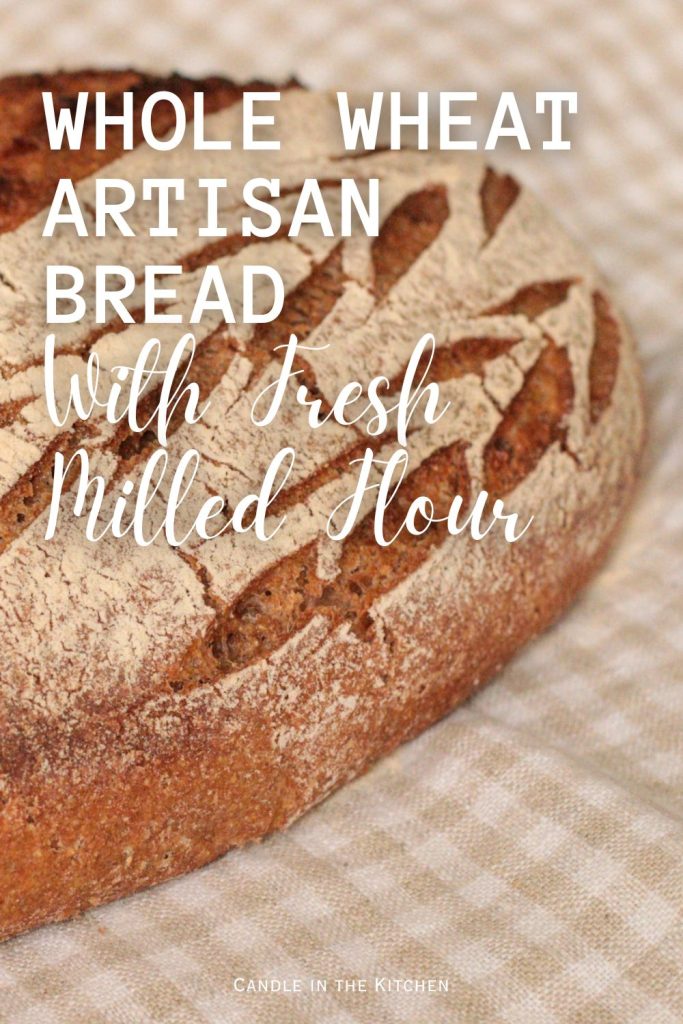
Why Bake Sourdough Bread with Fresh Milled Flour?
When flour is milled, it loses a significant number of nutrients. Commercial flour (even whole wheat flour) has the germ removed in order to make it shelf stable. This removes a huge amount of vitamins from the wheat, including vitamin E which is a powerful anti-oxidant.
Many people, including some in my own family, who have issues when they eat wheat (gluten), find that they are able to digest and thrive on bread and baked goods made with freshly milled flour.
The flavour is also delicious – it has a malted hint to it which I really enjoy.
If you would like to find out more, I recommend this video by Sue Becker from Bread Beckers.
Ingredients Needed to Make this Whole Wheat Artisan Sourdough Bread Recipe with Fresh Milled Flour
- 500g wheat berries (I use the equivalent of soft red wheat)
- 400ml filtered water (Note: see below for some important information)
- 50g active sourdough starter
- 10g salt
Ingredient Tips and Substitutions
Wheat Berries
The wheat berries you use will have a huge impact on the overall outcome of your bread. Here in France, I can only get soft wheat and, while I don’t know the exact variety, I think that it is red wheat. If you use a different kind of wheat, you will probably need to alter the water content as some wheat absorbs more water that others. The lower the gluten content of your wheat, the less water you will need. This will take some trial and error on your part to find the exact amount of water that is require for the wheat you are using.
Filtered Water
It is very important to use filtered, or unchlorinated water in this recipe, as chlorine will inhibit the bacteria from growing. We need the bacteria from the sourdough to grow so that the dough will ferment and rise!
Active Sourdough Starter
I like to feed my starter the night before with a very small amount of starter and a large amount of flour and water (for example, 25g starter, 100g fresh milled flour, 100g filtered water). This gives me a very strong starter that is ready to make bread in the morning. You will have more starter than you need for this recipe, but I love to use up that extra starter in recipes such as these muffins.
If you are looking to create a sourdough starter from scratch, The Clever Carrot has a great tutorial.
Salt
10g seems like a lot of salt, but it is necessary for this amount of bread. I prefer to use sea salt flakes, as it contains more minerals that are essential to our health. I prefer to avoid refined table salt wherever possible.
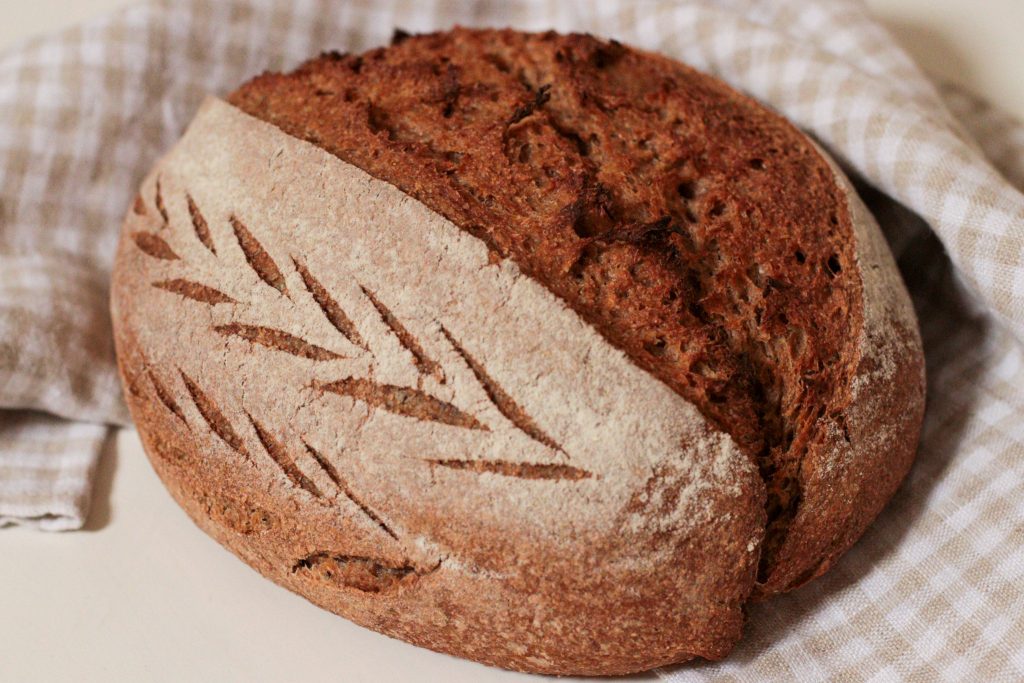
Whole Wheat Artisan Sourdough Bread Recipe with Fresh Milled Flour: Instructions
There are a lot of steps to this recipe, and I will give you a lot of tips and tricks along the way, but, take heart! It is actually quite simple and the recipe is easy to memorise so that you can make bread daily without even thinking about it!
I will give you two options for timing. The first one is if you are planning to mix the dough in the morning, the second is if you are planning to mix the dough in the afternoon.
The night before | The morning
Feed your starter. You will only need 50g for this recipe, so if you prefer not to have any left over, I suggest you use 10g starter, 25g fresh milled flour and 25g filtered water. This will give your starter a good feed but you won’t have any extra to use up.
If you would like extra starter to use in some sourdough discard recipes, you can increase these amounts accordingly.
If you don’t have very much time before you need to mix your dough, you can use a 1:1:1 ratio to feed your starter (for example 25g starter, 25g flour, 25g filtered water). This will speed up the time it takes for your starter to be ready to use.
You can also place your starter in a warm place so that it rises quicker. I like to use this heat mat, especially when the house is cold.
The morning | The afternoon
Once your starter has doubled, it is ready to use.
Mill the flour
Pour the wheat berries into your grain mill and mill on the finest setting possible.
Mix the dough
Using a danish dough hook, or your hands, mix together the milled flour, filtered water, starter and salt. Mix only until there is no dry flour left. It is important at this stage to not handle the dough too much as the bran in the flour needs to soften otherwise it will cut through the gluten strands, resulting in denser bread.
Cover with a plate or a damp tea towel and leave to rest for at least 30 mins and up to 1 hr.
Stretch and Folds
Over the next few hours, perform 3-4 stretch and folds, at least 30 mins apart. I don’t worry too much about the timing of the stretch and folds, I fit in as many as I can while the dough is fermenting. Make sure you cover your bowl in between stretch and folds.
Once you can see that the dough has started to increase in size and that there is a lot of air in the dough, stop doing the stretch and folds.
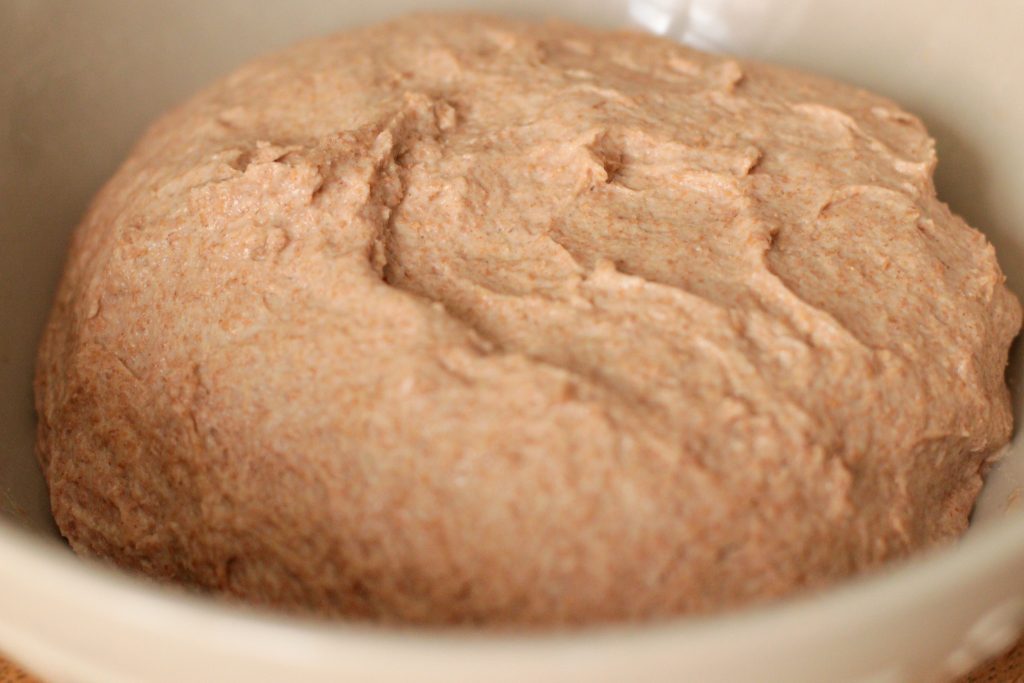
Bulk Fermentation
Next, cover your dough and leave it to bulk ferment.
This is the part that can really make or break your loaf of bread… I find that dough made with fresh milled flour ferments quicker than dough made with bread flour. Therefore, it is important to keep an eye on your dough.
Fermentation time depends on your home’s warmth, humidity, and the strength of your starter.
I’m not even going to tell you to wait until the dough has doubled – to be honest, in my experience, when the dough has doubled it has already over fermented!
Instead, I’m going to try and tell you what your dough should look and feel like…
It should be rounded on the top, full of air, but when gently pressed, the dough should spring back slightly.
When your dough looks like this, it is ready for the next step.
Note: I never leave dough made with fresh milled flour to ferment overnight – every time I have attempted this, it has been over fermented. If you need to wait until the next morning to shape your bread, but the bowl containing the dough in the fridge overnight and remove in the morning to continue to bulk ferment.
Shaping your bread
When your dough has finished its bulk ferment, dampen your worksurface, or lightly dust it with flour. Tip the dough onto the counter — it should release easily, with little left in the bowl (a good sign that it is well fermented).
I like to use a batard shaped banneton which I line with a linen cloth. The first couple of times I use a cloth, I flour it before putting the dough in it. Once it has been used a couple of times, it won’t need to be floured any more.
Shape the dough by first stretching it out flat on the surface, then bringing the edges into the middle to create a ball. Then turn the ball over so that the smooth surface is on the top. Create tension by pulling the dough towards you on the surface, using a cupped hand.
Using a bench scraper, pick the dough ball up and fold in in half so that it is an oval shape. Place in your prepared banneton basket and leave to rest for 5 mins (optional, but this helps the dough to relax).
‘Stitch’ the seam of the dough by pulling small parts of the edges from either side so that they overlap.
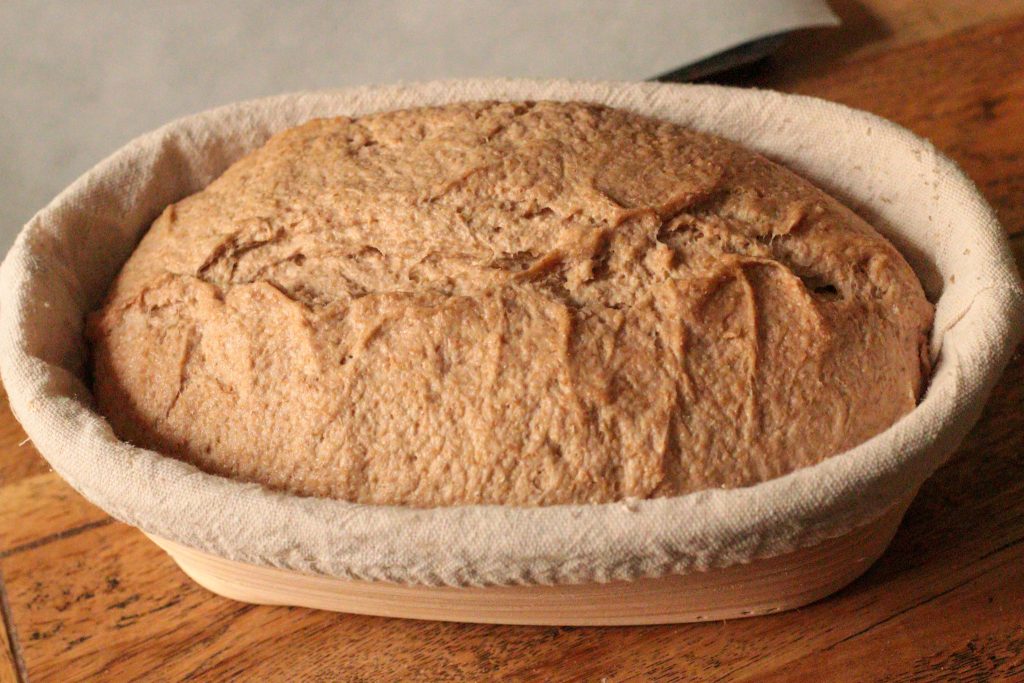
Cold ferment
Place the banneton basket containing the dough (without covering it) in the fridge overnight, or at least for 4hrs.
This will help the dough to hold its shape and rise well during baking.
The next day
When you are ready to bake your bread, preheat your oven to 230°C fan. Place a shallow pan in the bottom of the oven to preheat. Fill the kettle with water and boil.
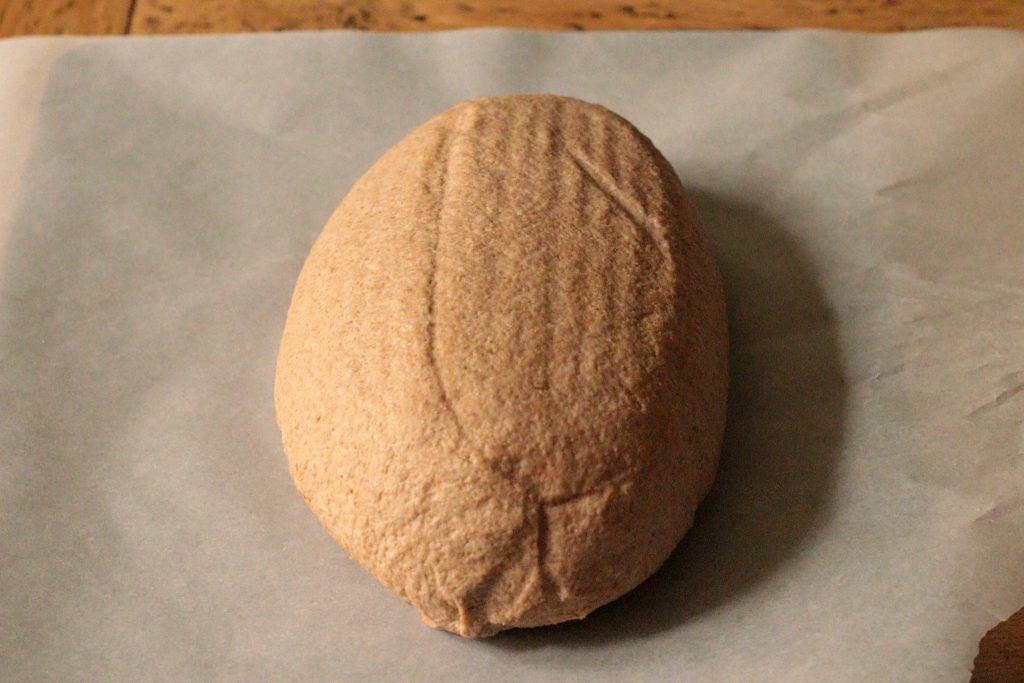
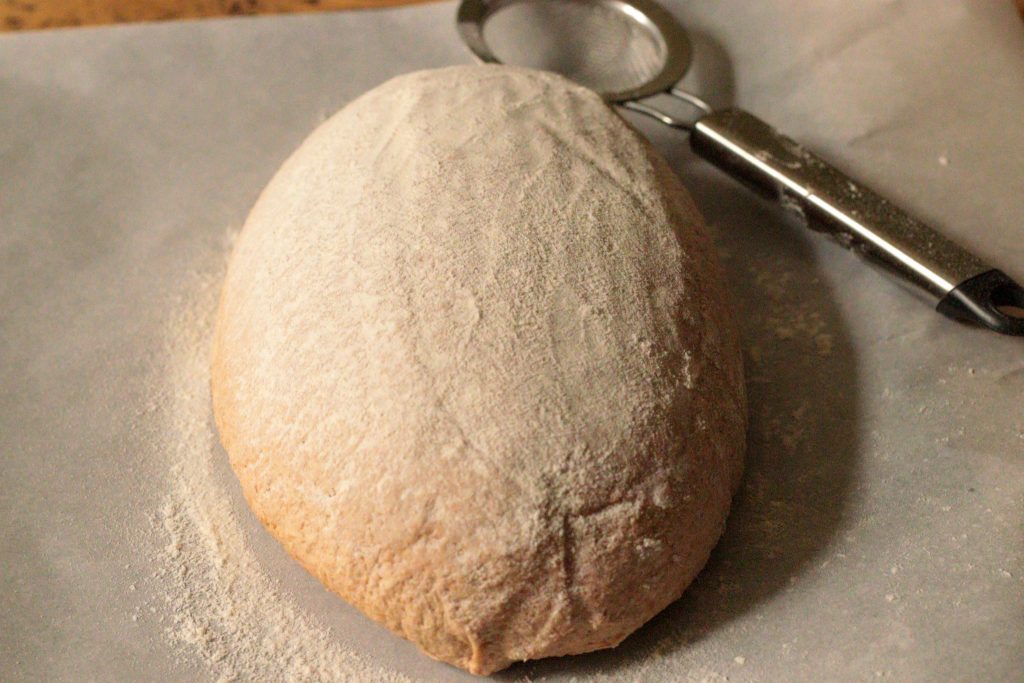
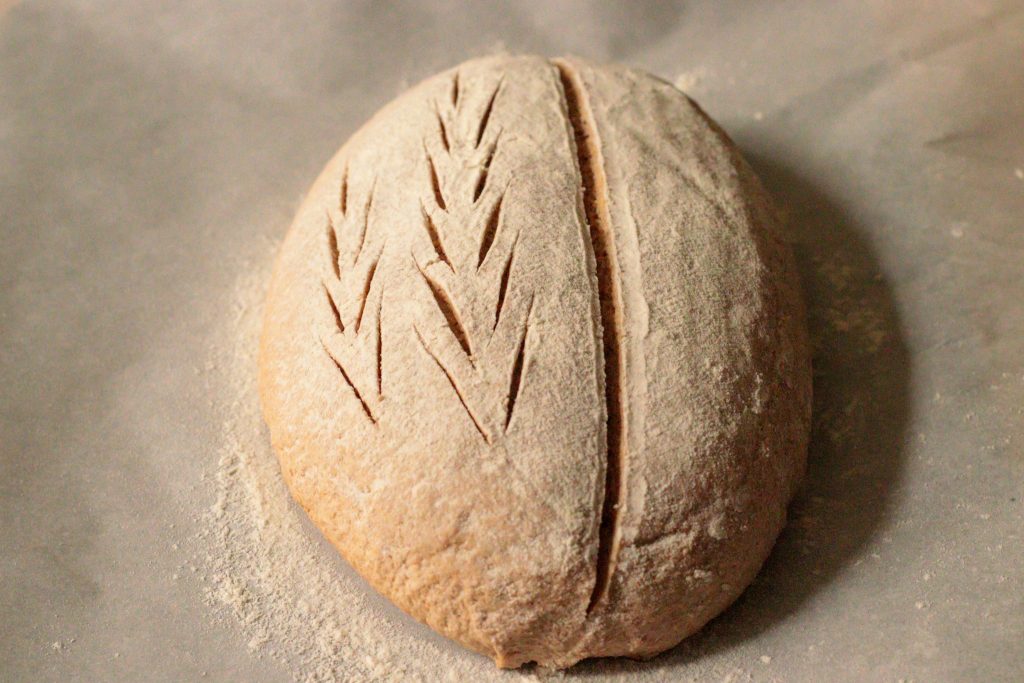
When your oven is hot, remove the dough from the fridge and carefully tip out onto a baking sheet. Using a baker’s lame, score the bread. Decorative scoring is trickier with fresh milled flour, but always make one deep cut to release steam.
Reduce the temperature of the oven to 200°C and place the bread dough in the the middle of the oven. Fill the hot shallow pan with boiling water. Bake for 20 mins.
Remove the shallow pan containing the water and continue baking for a further 20 mins.
Remove the bread from the oven and leave to cool for at least 45 mins before slicing.
Notes: I find that bread made with fresh milled flour has a tendency to burn, so it is important to reduce the heat to 200°C before putting the bread in the oven.
Filling a hot pan with boiling water will create a lot of steam, which will help your bread to rise and give you a lighter loaf.
If you are unsure as to whether your bread is cooked or not, use a food thermometer to measure the internal temperature of the loaf – it should be at 98°C.
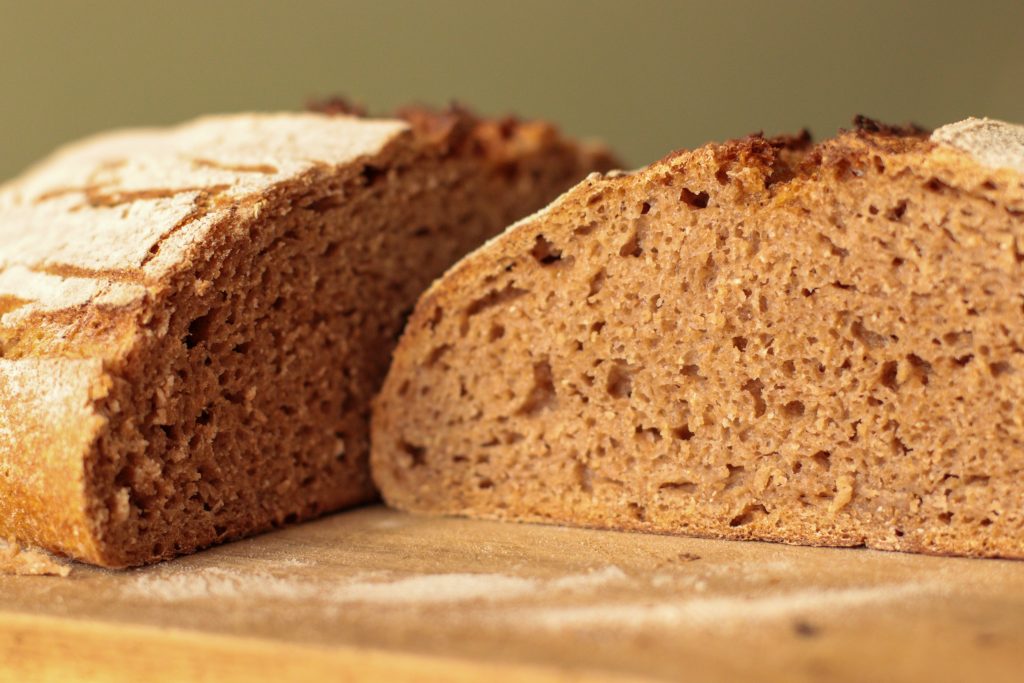
Top Tips for Baking Bread with Fresh Milled Flour
After months of trial and error, here are my best tips for baking sourdough bread with fresh milled flour. Do you have any others? Why not share them in the comments!
- Feed your starter with a large amount of flour and water so that it becomes very strong.
- Use your flour immediately after milling – it will be slightly warm and this will help kick off the fermentation process.
- Soak your flour with the wet ingredients before kneading to soften the bran.
- Do at least 3 stretch and folds. Stop doing the stretch and folds once the dough begins to rise.
- Your dough will ferment quicker than with bread flour, it may even seem slightly under fermented but if the top is a nice dome shape, and the dough springs back slightly when pressed, it is ready to shape.
- One deep score is enough for these loaves – decorative scoring is possible but doesn’t turn out as well. If you wish to do decorative scoring, dust your loaf with rice flour first, this will help the scoring stand out.
- Create steam in the oven by pouring boiling water into a preheated shallow pan.
- To obtain a good rise, preheat the oven to 230°C but reduce the temperature to 200°C before putting the bread in the oven to prevent it from burning.
- Allow to cool completely (at least 45 mins) before slicing.
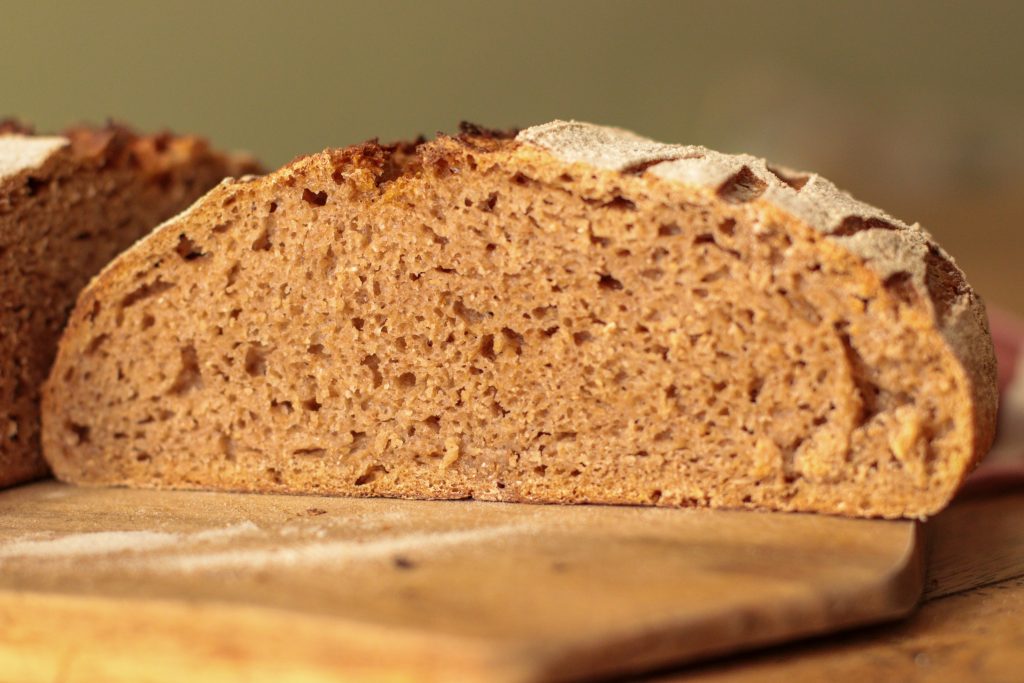
How to Store 100% Whole Wheat Sourdough Bread
This bread will store on the counter for several days, although it is usually best eaten within 3 days. If it dries out, toast it – it tastes just as good.
You can also freeze this bread either whole or sliced. If frozen whole, it will take several hours to defrost on the counter. Or you could reheat it from frozen in the oven at 150°C for about 15-20 mins.
In my experience, it is easier to slice the bread before freezing it. This enables you to take out just the amount of bread you need and a single slice of bread will defrost a lot quicker than a whole loaf. You can also place a piece of frozen bread directly in the toaster (you will normally need to increase the amount of time you toast it for).
How to Serve Whole Wheat Artisan Sourdough Bread
This bread is excellent toasted with cheese, or as a base for avocado toast. It also makes a great accompaniment to a bowl of steaming soup or a fresh salad.
Since there are not too many holes in this bread, it also makes a great sandwich.
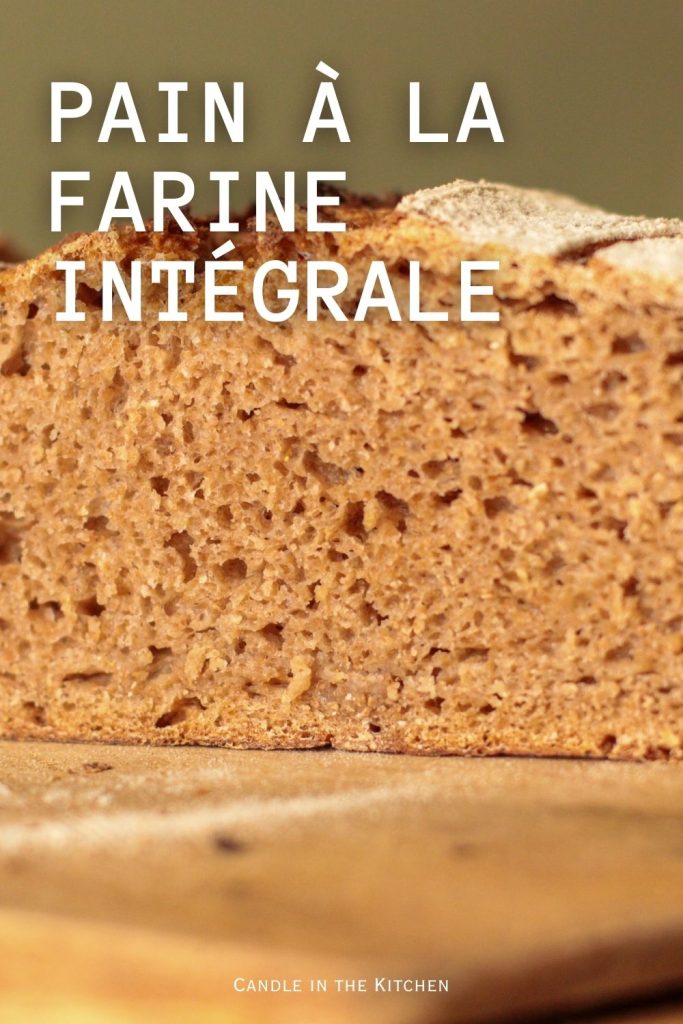
FAQs
How long does it keep?
This bread keeps for several days at room temperature on the counter. It will usually start to go slightly stale after about 3 days.
Is this bread gluten free?
No, this bread contains gluten. However, many people with gluten sensitivities (not coeliac disease) find that they can digest bread made with fresh milled flour. **Please do your own research and seek medical advice before trying this if you are allergic or sensitive to gluten.**
Is this bread dairy free?
Yes this bread is completely dairy free.
Can I freeze it?
Yes this bread can be frozen and reheated whole or sliced.
What are some possible add-ins?
If you would like to vary the flavour of your bread, you could try some different add-ins. I love to add seeds and grains (see my multigrain loaf) or dried fruits and nuts.
What should I do if my dough over ferments?
If you think that your dough has over fermented, don’t throw it out! You can either carry on and bake it as normal (the bread will be flatter and quite sour, but still very tasty!) or, you can turn it into a focaccia. Check out my focaccia bread recipe to find out how to shape it. This is my favourite way to use over fermented dough.
Did you try this whole wheat artisan sourdough bread recipe? I’d love to hear how it turned out for you. Leave a comment below and let me know your variation or serving idea — it’s always encouraging to see how these recipes fit into other family kitchens.
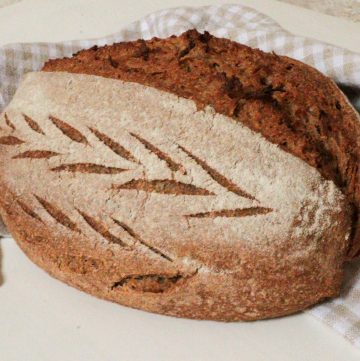
Whole Wheat Artisan Sourdough Bread Recipe (100% Fresh Milled Flour)
Ingredients
- 500 g wheat berries I use the equivalent of soft red wheat
- 400 ml filtered water see notes for some important information
- 50 g active sourdough starter
- 10 g salt
Instructions
- Prepare starter (night before): Feed your starter so it’s strong and bubbly by baking time.
- Mill flour: Grind wheat berries just before using.
- Mix dough: In a large bowl, combine flour, water, starter, and salt until no dry flour remains. Cover and rest 30–60 minutes.
- Stretch & fold: Over 2–3 hrs, perform 3–4 sets of stretch and folds. Stop once the dough is airy and starting to rise.
- Bulk ferment: Leave dough covered until domed and springy to the touch (do not wait for it to double).
- Shape: Tip onto a damp or lightly floured surface. Shape into a batard and place in a lined banneton.
- Cold ferment: Refrigerate 4–12 hrs.
- Bake: Preheat oven to 230°C with a shallow pan inside. Tip dough onto a tray, score, and reduce oven to 200°C. Bake 20 mins with steam (fill hot pan with boiling water), then remove pan and bake a further 20 mins.
- Cool: Leave loaf to cool at least 45 minutes before slicing.
Notes
- You may need to alter the amount of water in this recipe depending on the wheat you use (this will take some trial and error).
- For wheat with lower gluten content, reduce the amount of water.
- If your wheat has a high gluten content and the dough seems stiff when you first mix it, increase the amount of water slightly.
- Bread made with fresh milled flour ferments faster than with bread flour — keep an eye on dough rather than the clock.
- For lighter loaves, bake with steam.
- Loaf may brown quickly; reducing oven to 200°C prevents burning.
Storage
- Best enjoyed within 2–3 days.
- Store at room temperature, covered.
- Freeze whole or sliced; reheat at 150°C for 15–20 mins, or toast straight from frozen.

Leave a Reply